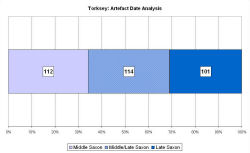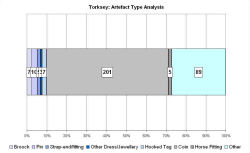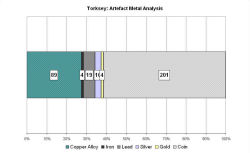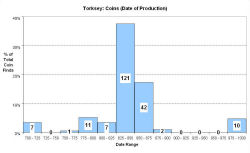Fingerprint charts for i) artefact date analysis, ii) artefact type analysis, iii) artefact metal analysis and iv) coins – date of production




References: Blackburn 2002; Brown 2006
Archives:
http://ads.ahds.ac.uk/catalogue/search/fr.cfm?rcn=EHNMR-1326013
http://ads.ahds.ac.uk/catalogue/search/fr.cfm?rcn=EHNMR-992892
http://ads.ahds.ac.uk/catalogue/search/fr.cfm?rcn=NMR_NATINV-324682
http://ads.ahds.ac.uk/catalogue/search/fr.cfm?rcn=NMR_NATINV-1245282
The name Torksey is derived from an Old English personal noun, with the addition of '-eg', meaning 'island'. Thus, the earliest written form of the name, found in the ASC entry for 873 as "Tureces iege," has been interpreted as 'Turoc's Island' (Watts 2004, 301), probably referring to an area of higher ground surrounded by waterlogged land. Although the site may once have been an island, the village of Torksey is now situated on the east bank of the River Trent, at its confluence with the Foss Dyke, a Roman waterway connecting Lincoln to the Trent. Till Bridge Lane, the Roman road that branches off Ermine Street north of Lincoln, passes through Marton, c. 3km north of Torksey, and crosses the Trent at Littleborough, before continuing north-west to York.
Torksey is widely known as a Viking winter camp from an entry in the Anglo-Saxon Chronicle for 872; it has also been suggested that it may have been one of 'Seven Boroughs' mentioned in the Anglo-Saxon Chronicle entry for 1015. Archaeological investigations from 1960-8 failed to find any evidence for defences, but did locate the kilns of an early medieval pottery industry that began in the mid-9th century and continued through to the 12th. Excavation in 1990 located an early medieval cemetery associated with the Church of All Saints.
Metal-detecting has confirmed that Scandinavian settlement at Torksey was not restricted to the winter camp of 872, with a strong Scandinavian presence also visible in the 10th century (Blackburn 2002). It has also demonstrated that Torksey was a Middle Saxon 'productive site', and that the Viking occupation must be considered in the context of pre-existing Saxon inhabitation.
The Early Saxon period is represented by a small number of finds, but evidence is sporadic prior to the 7th century. Middle and Late Saxon finds have largely come from the fields to the north of the present village, with a small cluster from the disused railway land to the south-east. The VASLE dataset is based on the catalogue of finds compiled by Brown (2006) as part of an unpublished University of York dissertation. This was itself based on the EMC and PAS as well as on further unpublished finds. Although the nature of the site remains ambiguous, and probably multi-functional, the finds are consistent with trade and exchange activity. The early 8th-century coins include continental sceattas and large numbers of Northumbrian stycas, ranging in date from the late 8th century to the second half of the 9th. Blackburn has suggested that these may be linked with Viking activity in the Lower Trent area – having come directly from Northumbria, members of the Great Army may have carried them as 'souvenirs' or small change as opposed to loot, given that they were very debased and of comparatively low value (1993, 82). They have been found in increasing numbers on sites in Lincolnshire, particularly along the Trent, and so probably reflect use as currency in this area in the Middle Saxon period. A lead trial bears the imprints of dies used for striking imitations of solidi of Louis the Pious (814-840) and may indicate local minting of these coins in the first half of the 9th century.
After a dramatic increase in the mid- and late 9th century, coin loss tails off in the 10th century, with a small resurgence in the early 11th, although the absence of coins cannot be equated with a downturn in commercial activity (Blackburn 2003, 32). Evidence for late 9th-century Scandinavian activity in Torksey is further confirmed by 75 Islamic dirhem fragments, at least 53 weights, as well as fragments of hack silver and gold.
The Middle Saxon productive site is reminiscent of 'classic' early minster sites and Stocker (2000, 189-91) has suggested a beach market located at Torksey, associated with St Margaret's church at Marton. However, there is no evidence for early ecclesiastical activity at Torksey itself. The site was clearly also an important centre of activity in the 9th century, with a strong Scandinavian presence associated with the Viking army's occupation, developing into proto-urban activity associated with pottery production.
Fingerprint charts for i) artefact date analysis, ii) artefact type analysis, iii) artefact metal analysis and iv) coins – date of production




© Internet Archaeology/Author(s)
URL: http://intarch.ac.uk/journal/issue25/2/4.4.60.html
Last updated: Tues Apr 21 2009